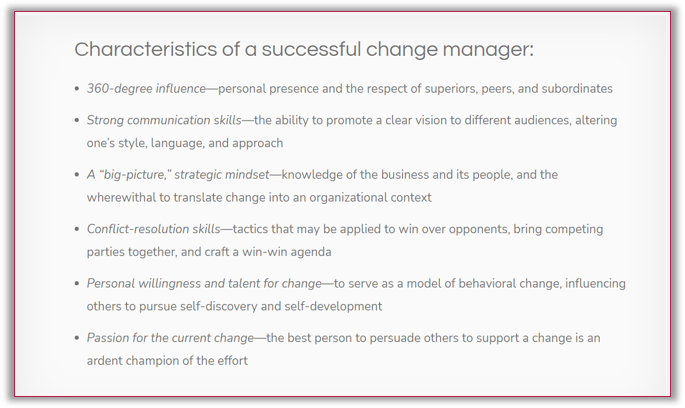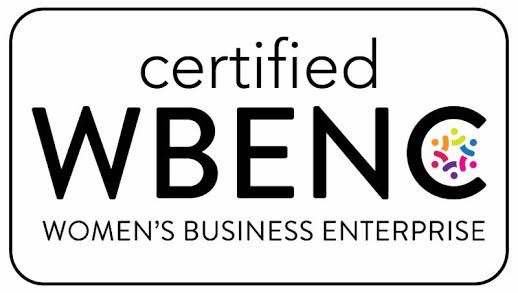NOTE: Previously shared, this oldie but goodie received a lot of interest and comments helping to further discussions on this ever-evolving topic – we included some additional tips from our readers in the conclusion.
It’s easy to recognize a new change manager. You can tell by the panic in their eyes, their trembling hands, and the beads of sweat on their brow. Believing themselves inadequate to drive the initiatives essential to business transformation, they might even be wailing, “I can’t do it! I don’t know anything about change!”
It’s no wonder change leaders are uneasy. If the last year taught us anything, it is that all organizations face change, and while we cannot control it, we can manage it with practice and focus. But before we can practice, we must identify a change leader. It’s not always obvious who is best suited to fill this challenging role. Hence, the senior team calls on the “usual suspects,” the same individuals they count on to lead special projects, task forces, and the like. That isn’t necessarily wrong, but change management requires much more than project management skills.
Individuals who have been tapped to lead change ask me, “What does it take to be a successful change leader?” Here are six tips that have served me well over the last 25 years and counting!
Learn the fundamentals of change management.
You have to start somewhere, and it only makes sense to school yourself in the philosophy, principles, models, and tools for change. These can be found in many excellent books, including Leading Change by John Kotter, Making Sense of Change Management by Esther Cameron and Mike Green, and Change Management: The People Side of Change by Jeffrey Hiatt and Timothy Creasey. Becoming familiar with the field will calm your fears, raise your confidence, and enhance your credibility as you promote change to others. While you’re studying, make sure you understand the basics of project management.
Get familiar with the current state of your business and industry, as well as the case for change.
Make sure you understand your organization’s business strategy, its challenges, and its short-term and long-term goals. Pay particular attention to the business rationale for change. Determine which business units and individuals will be impacted and how. Focus on those with the most to lose as well as the most to gain. Helping others see why change is an urgent business necessity and what the new and improved organization will look like, post-change, is one of a change manager’s most important roles.
Research your organization’s track record for change.
If this is your organization’s first formal change initiative, or if other major initiatives happened before your time, you may not know how proficient your organization is at change. Find out who led earlier projects and take advantage of their experience to learn the how, who, when, and why of circumstances that threatened or thwarted change efforts. Does the C-suite present a united front publicly but sabotage efforts behind closed doors? Is your organization skilled at communicating but weak when it comes to training delivery? Simply asking past project leaders, “What would you have done differently?” can yield a wealth of valuable information.
Find out how senior leadership feels about the upcoming change.
As the change management leader for your organization, you should have full access to the C-suite and their direct reports. Senior level support is critical for project success. However, it is rare to find full consensus, rarer still to identify the dissenters before all hell breaks loose. Proactively getting to know the executive team and where they stand on the initiative you are undertaking will help you identify—and possibly avoid—potential obstacles before they become divisive and disruptive. Building rapport with this group early on will serve you well, as you likely will need their advice and support throughout the project.
Get to know the project team and their consultants.
Like senior leaders, individual members of the project team have opinions and agendas. As a possible outsider and often a late addition to the project team, it is important for the change leader to take time to meet with team members to learn their history with the organization, the jobs they have held, and their experience with systemic and strategic change. Their personalities and profiles, their fears, and their biases about the current initiative will affect the decisions they make. Your awareness as the change leader will enable you to discern conflicts and influence outcomes.
Assess how you stack up against the skills and competencies of a change manager.
Some organizations name a change manager before they fully grasp the extent of the necessary skills and attributes. Others write a profile so unrealistic that John Kotter himself wouldn’t qualify. The box below describes six characteristics of successful change managers. Review it and conduct an honest assessment of your skills, either privately or with help from trusted colleagues. A clear view of your areas of strength as well as your shortcomings will enable you to take steps to shore up weaknesses or enlist associates who have the skills you lack.

Keep your ear to the ground.
It’s important to listen…to side conversations, to rumors passed on by friends and colleagues, to managers complaining about disgruntled employees or ineffective training. Not only does listening provide early warnings about misconceptions and burgeoning issues, but it will help you begin to identify allies and supporters who may join the change team as it expands. You may feel alone at the beginning, but ultimately the change team will grow to become an extended network that will participate in training and communication activities.
In a world where two out of three major change initiatives fail, one finding stands out: Organizations that consciously manage change, by activities like communicating, leading by example, and engaging employees, as much as double their chances for success. That is an astonishing statistic, and one that makes the role of change manager vital to business survival.
Additional wisdom from our readers:
- Focus on planning and preparation increases overall helps to success. One of our readers reminded us of this key piece of advice! If we build a plan to control the things we know are going to happen, it is much more likely that we will be able to respond to the unexpected things that happen throughout the project.
- Measure early and often. Measure what you are seeking to change and repeat these measurements periodically. This will help you identify faulty assumptions and make course corrections.
- Get a 2nd opinion. Even if you decide to do the work yourself, having an external advisor to provide another perspective may help you avoid the wrong path.


